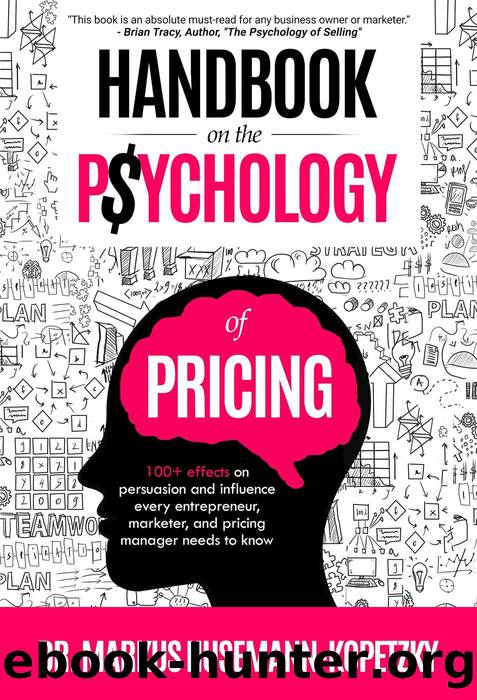Handbook on the Psychology of Pricing (9783947897025) by Husemann-kopetzky Markus

Author:Husemann-kopetzky, Markus
Language: eng
Format: epub
Tags: Psychology of Pricing, Priceless, psychological pricing, psychology of selling, psychology of persuasion, Methods of persuasion, why people buy, Brian Tracy, buyology, Cialdini, pricing, pricing strategy, pricing tactic, persuasion, exactly what to say, Hermann Simon, Pricing Man
Publisher: Draft2Digital
Published: 2018-10-04T16:00:00+00:00
Anchoring
Assimilation Anchors
PROBABLY THE MOST CITED study exemplifying the anchoring effect was conducted by Tversky and Kahneman (1974): Participants were asked to estimate the percentage of African countries in the United Nations. In the presence of participants, the conductor spun a fortune wheel with numbers between 0 and 100 and asked the participants to first indicate whether the percentage was above or below the number the fortune wheel delivered. Then subjects were instructed to provide their estimate. When participants saw a number of 10 or 65, they estimated percentages of 25 or 45, respectively.
These results showed that people anchored their estimate on an (arbitrary) number and insufficiently adjusted it from there afterwards (Tversky and Kahneman 1974). This insufficient adjustment is the characteristic of assimilation anchors: the anchor attracts the estimate like a magnet.
Applying this concept to pricing, Ariely, Loewenstein, and Prelec (2003) showed participants in an experiment different common products (cordless keyboard, average wine, Belgian chocolates etc.) that they could actually buy. At first, subjects should decide whether they were willing to pay an amount higher or lower than the last two digits of their social security number. Then they stated their maximum willingness to pay for each product. When the researchers compared responses from those students with a social security number in the top 20% to those in the bottom 20% they found the willingness to pay was two times higher for students with a high social security number confirming a strong anchoring effect also in the domain of prices.
In summary, providing a random number influences peopleâs judgment regardless of whether subjects are told this would happen, whether they are paid for accurate estimates or if the anchor is completely off (e.g. âIs the average temperature in San Francisco higher or lower than 558 degrees Fahrenheit (292 degrees Celsius)? What is the average temperature of San Francisco?â) (Quattrone et al. 1984; Tversky and Kahneman 1974; Wilson et al. 1996). Given the pervasiveness of the anchoring effect and its long history in various research disciplines, Ariely, Loewenstein, and Prelec (2003, p. 75) call it âan old trick from the experimental psychologistsâ arsenal.â
In the following, we look into how research applied the anchoring effect to pricing practice.
Expose consumers to any high number before they start evaluating prices.
Download
This site does not store any files on its server. We only index and link to content provided by other sites. Please contact the content providers to delete copyright contents if any and email us, we'll remove relevant links or contents immediately.
Influence: The Psychology of Persuasion by Robert B. Cialdini(4173)
The Miracle Morning by Hal Elrod(3903)
The Hacking of the American Mind by Robert H. Lustig(3575)
Pre-Suasion: A Revolutionary Way to Influence and Persuade by Robert Cialdini(3404)
Unlabel: Selling You Without Selling Out by Marc Ecko(2975)
Hidden Persuasion: 33 psychological influence techniques in advertising by Marc Andrews & Matthijs van Leeuwen & Rick van Baaren(2771)
Who Can You Trust? by Rachel Botsman(2729)
Kick Ass in College: Highest Rated "How to Study in College" Book | 77 Ninja Study Skills Tips and Career Strategies | Motivational for College Students: A Guerrilla Guide to College Success by Fox Gunnar(2716)
Purple Cow by Seth Godin(2694)
Ogilvy on Advertising by David Ogilvy(2677)
I Live in the Future & Here's How It Works by Nick Bilton(2520)
This Is Marketing by Seth Godin(2477)
The Marketing Plan Handbook: Develop Big-Picture Marketing Plans for Pennies on the Dollar by Robert W. Bly(2408)
The Power of Broke by Daymond John(2373)
Building a StoryBrand by Donald Miller(2358)
The 46 Rules of Genius: An Innovator's Guide to Creativity (Voices That Matter) by Marty Neumeier(2305)
Draw to Win: A Crash Course on How to Lead, Sell, and Innovate With Your Visual Mind by Dan Roam(2275)
The Tipping Point by Malcolm Gladwell(2200)
Market Wizards by Jack D. Schwager(2155)
